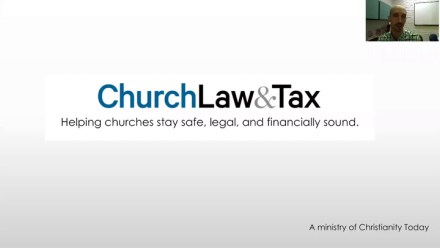Follow this guidance tracking budgets through various financial ratios, and learn why these measurements are important for building financial health.
For many of these ratios, the top number should be divided by the bottom number. This will produce a usable measurement for tracking trends and making comparisons.
Income and giving ratios
There are four ratios that can help you better understand your congregation’s giving patterns.
1. Net income ratio
change in unrestricted net assets
____________________________
unrestricted revenues
This ratio reveals the change in unrestricted net assets to unrestricted revenues. It shows whether your church’s general operations are positive or negative, and by how much. It answers the question of whether the church is making or losing money in its day-to-day ministry.
Obviously a church is not a business that’s trying to generate a profit to stockpile cash. However, if a church continually loses money in its basic operations, it will eventually have to close.
The benchmark for this ratio is a positive result for the year. A more important benchmark, however, is for the ratio to show an improving trend over the years, factoring in both years of surpluses and years of deficits.
2. Unrestricted contributions per average adult attendee and giving unit
unrestricted contributions
________________________________
average adult attendees and giving units
This measurement introduces the concept of a giving unit. A giving unit is a group of family members, or any recurring supporter, who contributes jointly to the church. This excludes individuals who make a smaller one-time gift supporting a specific event. To identify only the regular recurring giving units, set a minimum dollar threshold, such as giving units that contribute more than $250 annually.
This calculation can be compared to other years to see trends and determine the effects on the church and budget. It is also useful to calculate what contributions would be if every giving unit made a certain amount (e.g., $40,000 a year) and tithed on that amount. Your church could use this measurement to make the congregation aware of the current giving per adult attendee and giving unit, and what the projected giving level would be if everyone participated.
3. Total contributions per average adult attendee and giving unit
total contributions – the combination
of accrual pledges and large one-time gifts
______________________________
average adult attendees and giving units
The key difference between this result and the measurement of unrestricted contributions to average adult attendees and giving units is that this one uses total (unrestricted and restricted) contributions and removes the effect of pledges (which are essentially a noncash accrual) and large one-time gifts.
The power of this measurement comes through analyzing trends in congregational giving habits from year to year. During the period of a capital campaign this figure may be inflated due to an increase in smaller gifts, which are not removed from the calculation.
4. Median household income given to the church
total contributions per average
adult attendee and giving unit
(Measurement 3)
____________________________
local median household income
This ratio determines total contributions per average adult attendee and giving unit to local median household income (from the US Census Bureau, American Community Survey). It shows what percentage of the local median county household income adult attendees and giving units are contributing. In essence, it reveals the additional giving capacity of your congregation.
The trends in this data from year to year are important because there are two indicators that affect the outcome of this ratio: congregational giving and local median household income. For example, if local median county income decreased from one year to the next, the measurement could appear to increase while overall giving actually remained the same.
This measurement will enable church leaders to see changes in giving habits from year to year in response to stewardship teaching and focus.
Cash flow ratios
A church without necessary reserves will be scrambling to operate in the short term, no matter what the other balances are. Positive net income and net asset balances won’t make up for inadequate cash reserves or help in months when giving is down. Fortunately, there are five cash-flow measurements you can use to monitor reserves and identify any needed adjustments.
Numbers 1 through 3 offer different cash flow ratios you can use to calculate how many days of cash reserves your church has, using different perspectives from the financial statements. The result of each calculation is multiplied by 365 to determine a total number of days.
1. Days of expendable net asset reserves
unrestricted, undesignated net
assets + board-designated net
assets for operations
__________________________ X 365
cash expenses (total expenses – depreciation)
The first “days of cash” ratio tells how many days of operating expenses are available in net asset reserves. It takes into account the accrual of current assets and current liabilities. Expendable net assets represent the total resources available to spend on operations, excluding future gifts made or revenues generated by the church. It’s similar to a savings account.
Expendable net assets consist of unrestricted, undesignated net assets, which are net assets that result from achieving positive net income from all sources of revenues (excluding restricted revenues). It also includes amounts designated by the board for operating purposes other than capital expenditures. You divide this total by the amount of cash expenses to find your net asset reserves. Since all of these ratios measure cash flow, I use the term “cash expenses.” These are total expenses less deprecation, the most significant noncash expense recorded.
2. Days of operating cash and investments on hand to fund annual cash expenses
operating cash and investments
___________________________ X 365
cash expenses + capitalized interest
This second “days of cash” ratio calculates the days of operating cash and investments on hand to fund annual cash expenses specifically related to liquid assets. That means it only considers operating cash and investments, not other current assets and liabilities. Again, you divide operating cash and investment by the sum of cash expenses plus capitalized interest (interest paid in cash but not expensed by the church) to find on-hand funds.
This measurement will calculate a result that is slightly different (typically higher) than the first ratio (net asset reserves) because it does not include the impact of other current assets and liabilities.
An appropriate benchmark for this ratio is to have 40 to 80 days of cash expenses on hand. Furthermore, a result of less than 20 days could indicate that your church should take action quickly to improve this measurement.
3. Available days of cash flow coverage
operating cash and investments
___________________________ X 365
cash expenses (including debt principal payments)
This final “days of cash” ratio represents the number of days of operations (including making scheduled debt payments) available when calculated from the sum of operating cash flow. This number comes from the statement of cash flows, operating cash and investments on hand at the beginning of the year, and the amount available from the operating line of credit.
Again, divide beginning cash, cash flows from operations, and available line of credit by the amount of total cash expenses and debt principal payments.
Here’s another way to state this: If your church used all of the cash generated from operations, all available cash and investments on hand at the beginning of the year, and your available line of credit, how many days would you be able to operate on these sources of cash? This number represents your maximum level of reserves, and should always be the highest of the three “days of cash” numbers.
4. Liquidity ratio
operating cash and investments
_______________________________
current liabilities – building fund current
liabilities, deferred revenue, and short-term
construction line of credit
The liquidity ratio measures how operating cash and investments are able to cover current operating liabilities, which exclude current building fund liabilities. (These typically have a separate source of cash from restricted revenues or budgets.) This ratio reveals how many times actual operating liabilities can be funded from operating reserves.
Divide operating cash and investments by current liabilities (excluding those items noted in the ratio).
A low result may indicate that the church is keeping fewer liquid reserves and is less likely to be able to handle unexpected operating expenses, events, or new opportunities that may come along.
5. Net cash availability measurement
total cash and investments – adjusted current liabilities (current liabilities excluding amounts borrowed on a construction line of credit) and temporarily restricted net assets
The fifth and final cash flow item is not a ratio but a measurement of the sum of total cash and investments less certain amounts the church may owe or be required to spend for specific purposes due to donor restrictions. This measurement calculates the amount of cash available for other uses after the church has satisfied its adjusted current liabilities and set aside appropriate funds for temporarily restricted projects. Amounts borrowed on a construction line of credit are also excluded, as they will ultimately be refinanced with the debt and paid over time.
Your statement of financial position answers the question, “How much cash do we have?” but it doesn’t answer the question, “Whose cash is it and how much of it can we spend?” The answers to those questions are typically very different. Therefore, this is one of the most important measurements you can provide church leadership.
The minimum for this number is at least one month’s worth of cash expenses. Any positive amount less than this is in the warning range. Any negative amount indicates the church is borrowing from temporarily restricted funds—a warning that corrective action is needed.
Expense ratios
Expense ratios can help identify trends in the outflow of resources over the years. They also allow you to compare your church with other churches and check the reasonableness of your expenses.
1. Personnel and mandatory debt service payments to total expenses (excluding depreciation expenses)
personnel (salaries including benefits)
+ mandatory debt service payments
(principal + interest expense)
________________________________
total expenses – depreciation expense
The largest expense of most churches is salaries and benefits. Debt service payments—which are a reduction of a liability and not an expense—represent the second largest outlay. Together, these items represent a majority of resource outflows from the local church.
Continually monitor these levels as a percentage of cash expenses. Cash expenses are total expenses minus depreciation, the most significant noncash expense recorded. It is also important to promptly follow up on changes in trends or unusual variances from peers to ensure that your resources are continually maximized.
This ratio, which can be split into two separate pieces, allows you to look at two of your largest outflows and determine the portion of the operating budget that will be used. Often, a growth cycle results in an amount of debt the church anticipates being able to pay off as more people start attending. However, the church needs to be able to pay the bills and provide the services that will attract new people with the current budget. Reviewing this ratio in advance of any major debt decisions will help you analyze the feasibility of facility expansion goals.
Reasonable benchmarks for these ratios are:
- Personnel costs (salaries and benefits) should fall between 40 percent and 55 percent of expenses.
- Mandatory debt service payments, including interest, should be no more than 15 percent of total expenses.
- Total personnel and debt service costs should be no more than 40 percent to 70 percent of total church expenditures.
2. Expenses (excluding depreciation) per average adult attendee and giving unit
total expenses (excluding depreciation expense)
________________________________
average adult attendees and giving units
This measurement tells you the cost to the church for each adult attendee or giving unit. It takes total cash expenses and divides that total by the average adult attendees or giving units.
The power of this measurement is in the peer group comparison. This allows your church to see if your cash expenses are high or low compared to your peers. Analyzing trends over the years is also important. Another benefit of this measurement is that it can be subtracted from total contributions per attendee and giving unit to show if contributions are high enough to cover the monetary cost per individual. In other words, are you taking in enough contributions to cover the costs of having people attend your church?
3. Total missions categories to total expenses
total outreach expenses (local and global)
_________________________________
total expenses
This ratio looks at the combined total of local and global outreach (missions and benevolence) expenses as a percentage of total expenditures. It can be separated into two pieces and calculated by local and global activities. Global activities include actual expenditures for cross-cultural missions activities in the United States and other countries. This includes direct support to missionaries; outside agencies, including national partners; and cross-cultural missions trips. It excludes internally allocated costs and salaries of employees included within missions for some church budgets. This is because internal allocations vary significantly among churches.
Local outreach includes expenditures for local missions activities not classified as “global.” This includes direct support of community-based church ministries, local missionaries and agencies, and benevolence given to local individuals. It excludes internally allocated costs and salaries of church employees included within missions for the same reason as stated above.
This ratio can be useful in benchmarking your total outreach expenditures with other churches. More importantly, when a church experiences economic difficulties, the ministry and mission expenses are usually the first to be decreased as debt service payments are not discretionary and personnel costs are difficult to reduce. Declines in this ratio can allude to other issues. Monitoring these ratios over time will allow the church to identify any significant changes.
4. Facility cost per square foot (excluding interest expense)
total facility costs (excluding interest
expense on the debt and depreciation)
_______________________________
total facility square footage
This measurement answers the question, “How much does it cost to operate the church building?” Total facility costs include building and grounds maintenance, personnel salaries and benefits, outside contract labor, utilities (excluding telephone), security, liability insurance, and rent or mortgage payments. It should also include the cost of general repairs to the facility and other facility-use expenses, but not equipment purchases or the cost of major renovations. This overall expense excludes both vehicle-related expenses and interest expense on debt and depreciation.
Facility expenses measurements can vary, depending on whether the church has new or older facilities and is in one or multiple locations. Facility expenses measurements can also vary by geographic area. The most accurate comparison would be against churches with buildings of a similar age as yours (e.g., built within a decade of your own).
The ratios detailed above can provide valuable insights for leaders. They are tools that can be used proactively to minimize the need to respond to financial crises later.
Related articles:



















